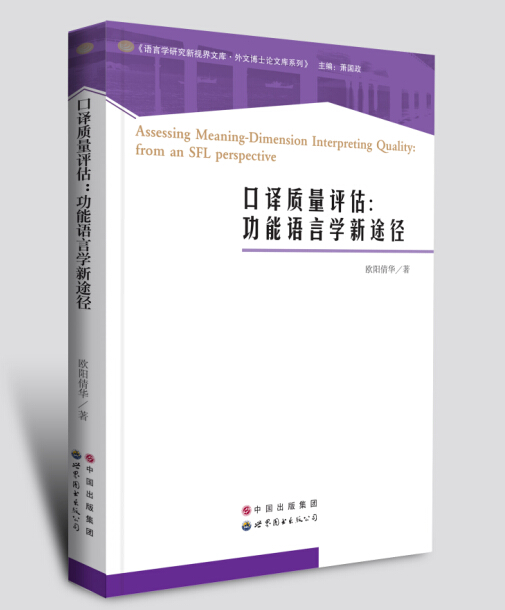博文
书名:《口译质量评估:功能语言学新途径》 作者:欧阳倩华
|
书名:《口译质量评估:功能语言学新途径》
作者:欧阳倩华 著
出版社:世界图书出版公司
出版时间:2015.9
定价:42.00元
ISBN:978-7-5192-0180-7

作者简介:
欧阳倩华,祖籍湖南,曾先后在广东外语外贸大学、澳门大学攻读学位,获文学学士、文学硕士及哲学博士学位。为国际翻译与跨文化研究协会(IATIS)会员、中国翻译协会会员、澳门翻译员联合会创会会员、广州翻译协会理事、广东外语外贸大学高级翻译学院口译系讲师、广外翻译学研究中心兼职研究员。主要研究方向为口译教学,口译质量评估及口译中的语篇分析。曾先后发表多篇论文,参与三部口译教材和口译词典的编写,目前主持两项口译研究相关科研项目。拥有多年国际会议传译经验,参加过数百场国际会议的交替传译和同声传译工作,服务对象包括政府部门、大型企业、使领馆、学术机构等。
内容简介:
本书以系统功能语法对语言意义的分析为基本框架,与口译用户期待研究所总结的主要评估标准相结合,从准确性、恰当性和连贯性三个方面建构一个口译意义传递质量评估模型,并将所建模型应用于评估学生的英汉交替传译语料,以验证其适用性,并具体展示模型的使用步骤。
目 录
Chapter 1 Introduction 001
1.1 Disciplinary background of the book 001
1.2 Challenges facing interpreting quality assessment and
a possible solution 003
1.3 Research goals of the book 005
1.4 Research methods of the book 009
1.5 Organization of the book 011
Chapter 2 Defining consecutive interpreting in the context of
interpreting teaching 013
2.1 Defining consecutive interpreting 013
2.2 The transfer of meaning in CI 016
2.3 Teaching consecutive interpreting 022
Chapter 3 Language meaning in interpreting: through the eyes of Systemic
Functional Linguistics 025
3.1 SFL: an introduction 025
3.2 Language meaning: three metafunctions 032
3.3 SFL and translation quality assessment 044
Chapter 4 Interpreting quality assessment literature 047
4.1 Empirical studies on IQA 048
4.2 Common Criteria in interpreting assessment 050
4.3 Interpreting quality assessment models for the training purpose 052
4.4 Summary 054
Chapter 5 Status quo of IQA in the training setting 055
5.1 IQA from the eyes of students: the survey 055
5.2 IQA from the eyes of trainers: the interview 064
5.3 Summary 070
Chapter 6 Setting up the model 071
6.1 The issue of validity and reliability 072
6.2 Overview of the model 074
6.3 Implementation of the model 080
6.4 Pilot application of the model 083
6.5 Summary 089
Chapter 7 SFL based quality assessment of students' interpretation 090
7.1 Data collection and corpus building 090
7.2 Assessing C-E interpreting 097
7.3 Assessing E-C interpreting 123
7.4 Summary 142
Chapter 8 SFL based assessment and interpreting teaching 143
8.1 Use the assessment results in interpreting teaching 143
8.2 Notes on model application 154
8.3 Summary 159
Chapter 9 Conclusion 161
Appendix Ⅰ Transcription of source speech of C-E Interpreting 168
Appendix Ⅱ Transcription of source speech of E-C Interpreting 170
Appendix Ⅲ Lexicogrammatical analysis of the C-E ST 172
Appendix Ⅳ Lexicogrammatical analysis of the E-C ST 181
References 186
Postscript 197
https://blog.sciencenet.cn/blog-582016-928062.html
上一篇:书名:《中英文学作品中的文化翻译研究》
下一篇:书名:《英语语言功能研究》 作者:郑世高 戴卫平